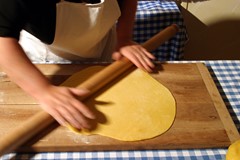Ancient Culinary Arts in the Montecuccoli age
On our historic itinerary in the footsteps of Raimondo Montecuccoli and his ancestors - who dominated the central Frignano region from the beginning of the second millennium - we cannot ignore the culinary tradition, which has reached our own times richer and more elaborate, while continuing to feature the ingredients and flavours of years gone by.
The importance of food, not just as a form of sustenance, but also as a real gastronomic art, the end result of much creativity and research, is shown in the priceless medieval and Renaissance recipe books that traditional cooking derives from. Dishes which find their origin in peasant tradition, but also in the recipes prepared at the homes of noble feudatories. In those times much use was made of game, pork (farm animals always included pigs from the Middle Ages onwards), wild greens, pulses and chestnuts, a high protein food.
Tradition has it that in the 1500s Countess Ricciarda Molza, the wife of Galeotto I Montecuccoli and grandmother of the famous General Raimondo, was very fond of cooking and would prepare delicious dishes for the banquets organised in honour of important guests. So never fear that after visiting a village or castle that you will be unable to find a restaurant or trattoria to continue your journey, in this case, through the delights of top-class home-made cooking.
Arguably the most traditional and most widespread dish in the Apennine hills is the crescentina, commonly known as a tigella, made from dough containing flour, water and yeast and originally cooked between small discs of terracotta, called tigelle, heated beforehand until red hot in the fireplace. The tigella is accompanied by salumi or a paste of lard, garlic and rosemary.
Another delicacy is borlengo, common in the Guiglia area, which is a crisp piece of puff pastry cooked on large metal plates which is then spread with a lard mixture and Parmesan Cheese. No less important is the ciaccio, a kind of tigella but softer, typical of the Palagano area.
Fresh pasta hand rolled is the basis for creating tortellini, to be cooked only in stock, and tortelloni filled with potatoes, as is traditional at Montese, or more commonly Ricotta cheese flavoured with sage. Lastly there is no shortage of roast or stewed meat and dishes based on mushrooms and, at Montefiorino, matchless truffles.
To brighten up the meal, some sparkling Lambrusco to lighten the calories of a cuisine that is never less than substantial. But the gastronomic experience does not end here; there are still desserts to be tried such as those based on woodland fruit or chestnuts, plus jam tarts and fritters. At this point your host cannot let you leave without first offering you a taste of local liqueurs such as walnut Nocino, Laurino based on laurel berries, juniper liqueur, or woodland fruit grappa.
And then all that remains is to take up our journey again to get to know the vast ancient fiefdom of the Montecuccoli.
To try succulent seventeenth-century recipes, food buffs can get hold of the Ricettari della Contessa Ricciarda (the Countess Ricciarda’s Recipe Book), a fascinating publication that is the result of research into collections of ancient medieval and Renaissance recipes and popular tradition, which reintroduces preparations and ingredients from a long gone culinary tradition, that remains appetising and enjoyable to this day.
